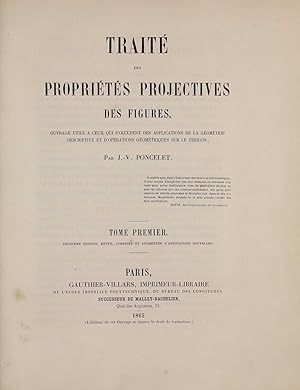Beschreibung
Dedication copy to Elie de Beaumont, inscribed and signed by the author, also signed by publisher. 1865-1866. Two parts in two volumes. 4to (273 x 220 mm). i-ix [2] x-xxxii, 428 pp., 12 engraved plates; [viii], 452 pp., 6 engraved plates. Contemporary three-quarter sheep over grained percaline boards, gilt-lettered spines with 5 raised bands, gilt-stamped author's name to upper boards (rubbing to spine and extremities, partial chipping of percaline coating, corners bumped and worn), marbled endpapers. Text very little age-toned, occasional very minor spotting, a few annotations in pencil, 3 leaves with short tear to lower corner, little fraying to fore-edge of one plate, faint little foxing to plates in vol. I, final text page of each vol. somewhat browned and foxed, but generally quite clean and bright. Provenances: George Philip (book plate to front pastedowns); Jean-Baptiste Elie de Beaumont* (author's inscription to first free endpaper of first vol. "a Monsier Elie de Beaumont / Souvenir de haute estime / J. Poncelet"). Both vols. also inscribed in ink by the publisher "Gauthier Villars" on half-title verso (little off-setting of ink to title-page). ---- DSB XI, p. 78-80. SECOND EDITION, much enlarged. Poncelet, a pupil of Monge, "during his years in the prisons of Russia, meditated on the real cause of the power which algebraical analysis possessed, on the reason why geometry proper was deprived of it, and what might be done to give it a similar generality. . . . He was thus led to the enunciation of his celebrated and much-criticised principle or law of continuity. Analytical geometry, by substituting an algebraical expression for a geometrical figure, could apply to it all the artifices of abstract analysis" (Merz). In this book Poncelet announced his discovery of the principle of projection and the principle of figures. The Traité "was the first book wholly devoted to projective geometry, a new discipline that was to experience wide success during the nineteenth century. In this domain Poncelet considered himself the successor to Desargues, Blaise Pascal, and Maclaurin and the continuator of the work of Monge and his disciples. Concerned to endow pure geometry with the generality it lacked and to assure its independence vis-à-vis algebraic analysis, Poncelet systematically introduced elements at infinity and imaginary elements, thus constructing the space employed in complex projective geometry. Basing his efforts on the principle of continuity and the notion of ideal chords, he also made extensive use of central projections and profitably utilized other types of transformations . The distinction Poncelet made between projective and metric properties prefigured the appearances of the modern concept of structure. Among the many original results presented in the Traité are those stating that in complex projective space two nondegenerate conics are of the same nature and have four common points (a finding that led to the discovery of cyclic points, imaginary points at infinity common to all the cirlces of a plane), and that all quadrics possess (real or imaginary) systems of generatrices. The decisive influence that Traité des propriétés projectives des figures exercised on the development of projective geometry . is brought to light by most commentators, particularly by E. Kötter, who made the most complete analysis of it. . . Of the later memoirs, the most striking is devoted to the theory of reciprocal polars, which in Poncelet's hands became an extremely fruitful instrument of discovery, although he did not perceive the more general character of the principle of duality, which was pointed out shortly afterward by Gergonne, Plücker, Möbius, and Chasles. Although it was prematurely interrupted, Poncelet's geometric work marks the first major step toward the elaboration of the fundamental theories of modern geometry." (DSB). * Élie de Beaumont's name is widely known to geologists in connection with his. Bestandsnummer des Verkäufers 002979
Verkäufer kontaktieren
Diesen Artikel melden
![]()




